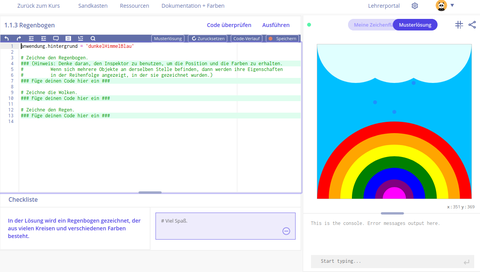Workshop - Python interaktiv und grafisch mit der CMU CS Academy
1 Überblick
Für die Vermittlung der Grundlagen der textuellen Programmierung, insbesondere in der Mittelstufe, wird eine Online-Plattform vorgestellt auf der die Grundlagen der Programmierung in Python erlernt werden können. Die Plattform „CMU Computer Science Academy“ wurde von der Carnegie Mellon University (CMU) (Pittsburgh, USA) für den Computer Science 0 Kurs (CS0) an amerikanischen Highschools entwickelt und dort seit 2015 mitmehr als 5000 Schüler:innen getestet und verbessert. In Kollaboration mit der Carnegy Mellon University hat die die Professur für Didaktik der Informatik an der TU Dresden die deutsche Übersetzung der CMU Computer Science Academy erstellt. In 2020 wurde der Kurs CS 0 vollständig ins Deutsche übersetzt. Neben den Texten, Codebeispielen und Kommentaren betrifft dies ebenfalls die grafische Bibliothek (Objekte, Funktionen, Methoden und Parameter) sowie die Compilerrückmeldungen. Im Zuge der Kooperation wurde eine neue Instanz der CMU Computer Science Academy auf Servern in Frankfurt mit einer eigenen Nutzerdatenverwaltung aufgesetzt und ist kostenlos nutzbar.

Abb. 1: Blick in die CMU CS Academy
Die CMU Academy verfolgt einen interaktiven Ansatz, indem die Programmieraufgaben direkt in die erklärenden Inhalte eingebettet sind und auch im Browser inklusive Compilerrückmeldungen bearbeitet werden können (siehe Abbildung 1). Kern der Programmieraufgaben ist das Erstellen von grafischen 2D-Ausgaben durch einfache Grundformen (Rechtecke, Kreise etc.). Durch das Kombinieren und Verändern der Formen entstehen angeleitet komplexe Grafiken, die bei den anfänglich wenigen bekannten Programmierkonstrukten die Anwendung dieser motivieren. Im weiteren Verlauf des Kurses werden dann Animationen und Eingabeinteraktionen eingeführt (siehe Tabelle 1).
Die Anmeldung zur Plattform kann nur von Lehrenden vorgenommen werden. Eine Lehrperson legt nach der Freischaltung Kurse an und kann Accounts für Schüler:innen generieren oder über einen Link eine direkte Registrierung der Schüler:innen ermöglichen. Neben der Administration der Kurse können die Lehrenden die Lernfortschritte und Lösungen der Teilnehmenden einsehen und gezielt Feedback geben (siehe Abbildung 2).

Abb. 2: Lehrendenperspektive
Neben der Vorstellung der Möglichkeiten sollen folgende fachdidaktischen Fragestellungendiskutiert werden:
- Sind deutsche Übersetzungen von Compilerrückmeldungen und Quellcode (Klassen,Parameter, Methoden etc.) fachdidaktisch sinnvoll?
- Wie können (Teile von) umfangreichen Programmierlernplattformen in den Informa-tikunterricht sinnvoll integriert werden?
- Welche zusätzlichen, begleitenden Materialien und Inhalte würden die Passung der Plattform für den Einsatz im Informatikunterricht verbessern?
2 Workshopkonzept
Der Workshop ist in fünf Abschnitte unterteilt. Zuerst wird die Programmiersprache Python als Lehr-Lern-Sprache diskutiert und die Einbettung in die Informatik-Lehramtsausbildung an der TU Dresden vorgestellt. Anschließend folgt eine Präsentation der Inhalte und Einsatzmöglichkeiten mit einer längeren Phase des eigenen Erkundens der Plattform aus der Perspektive der Lernenden. Darauf folgt der Perspektivwechsel in die Lehrendenansicht, die zuerst vorgestellt und dann diskutiert wird. Im Anschluss wird gezeigt, wie die grafische Bibliothek offline in der Entwicklungsumgebung Thonny genutzt werden kann und damit die Möglichkeit besteht, von dem geleiteten Einstieg in die Programmierung über die Plattform zum freien Programmieren in einer IDE zu wechseln. Den Abschluss bildet ein Vergleich mit einer anderen Programmierplattform unter der Nutzung von Python mit Raum für eine offene Diskussion.
Aufbau des Workshops
| Perspektive | Inhalt | Zeitplanung |
|---|---|---|
| Einführung Organisation |
|
10 min |
| Perspektive Schüler:innen |
|
50 min |
| Perspektive Lehrkräfte |
|
25 min |
|
Perspektive |
|
15 min |
| Fazit und Ausblick |
|
20 min |